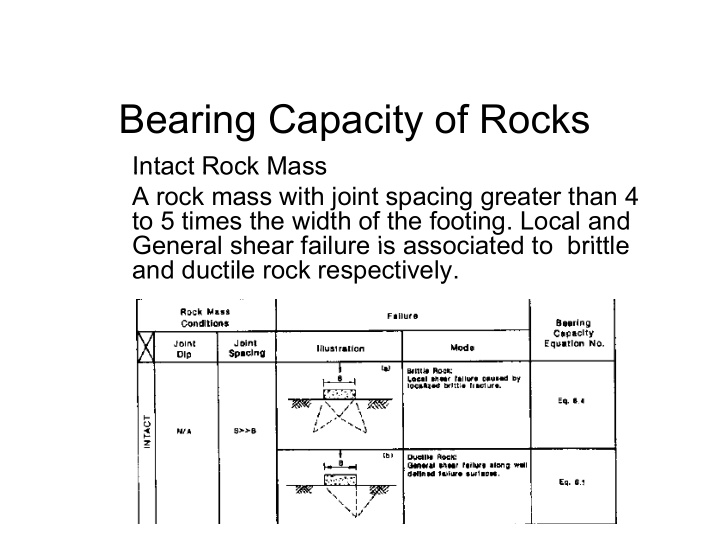



Bearing Capacity of Rocks Intact Rock Mass Intact Rock Mass A rock mass with joint spacing greater than 4 to 5 times the width of the footing. Local and General shear failure is associated to brittle General shear failure is associated to brittle and ductile rock respectively.
Jointed Rock Mass Jointed Rock Mass
General Shear Failure Local Shear Failure Local Shear Failure
• Compressive Failure: A case characterized by poorly constrained A h t i d b l t i d columns of poor rock. Splitting Failure For widely spaced and vertically oriented For widely spaced and vertically oriented discontinuities, failure generally initiates by splitting beneath the foundation.
• The ultimate bearing capacity is given by:
Guideline properties of Rock Mass Cl Classes
Allowable Bearing Stresses on Rock Masses Foundations on Fractured Rock Formation 30 MPa) Note: Use maximum q a < q u where q u compressive strength where q u = compressive strength ress q a (M 25 of intact rock specimens 20 earing Str ( RQD / 16 ) ≈ + q ALLOWABLE ( MPa ) 1 − 15 1 ( RQD / 130 ) NOTE: 1 MPa = 10 tsf NOTE: 1 MPa = 10 tsf owable Be 10 Peck, et al. (1974) ( ) 5 Allo Approximation 0 0 10 20 30 40 50 60 70 80 90 100 Rock Quality Designation, RQD
In case of rock mass with favorable discontinuities, the net allowable bearing pressure may be estimated from: q a = q c * N j Where q c = average uniaxial compressive strength of rock cores Where q c average uniaxial compressive strength of rock cores N j = empirical coefficient depending on the spacing of the discontinuities + 3 S / B = [ ] + δ 10 1 300 ( / S ) δ = thickness of discontinuity δ = thickness of discontinuity S = spacing of discontinuities B = width of footing The above relationship is valid for a rock mass with spacing of continuities > 0.3 m, δ < 10 mm (15 mm if filled with soil) and B >0 3 m B >0.3 m.
Pile Foundations: The allowable bearing capacity of socketed piles is given by: q a = q c * N j * N d Where Where N d = 0.8 + 0.2 h/d h = depth of socket in rock d = diameter of socket Determination of Net Allowable Bearing Pressure from P Pressuremeter Test: t T t [ ] 1 = γ + − γ q D K P D ( ) a f d l f 3 Where q a = allowable bearing pressure in t/m 2 P l = limit pressure determined by the Pressuremeter in t/m 2 γ D f = overburden pressure in t/m 2
Values of K d Values of K d Depth of footing Depth of footing K d K d Load at rock surface 0.8 Load at radius/width of foundation 2.0 unit Load at 4 times radius/width of 3.6 foundation unit Load at 10 times radius/width of 5.0 f foundation unit d ti it
Plate Load Test Plate Load Test
Correction Factors : (Not required for RMR) Co ect o acto s ( ot equ ed o ) • Ground Water Table: (a) Rock with discontinuous joints with opening less (a) Rock with discontinuous joints with opening less than 1mm wide – 0.75 (b) Rock with continuous joints with opening 1 to 5 mm wide filled with gouge – 0.7 to 0.5 id fill d ith 0 7 t 0 5 (c) Limestone/ Dolomite deposit with major cavities filled with soil – 0.66 to 0.5. • Cavities: Major cavities inside limestone - 0.5 • Slope and orientation of joints: ( ) F i (a) Fair orientation of continuous joints in the slope – i t ti f ti j i t i th l 1 to 0.5 (b) Unfavorable orientation of continuous joints in (b) Unfavorable orientation of continuous joints in slope – 0.5 to 0.33.
Recommend
More recommend